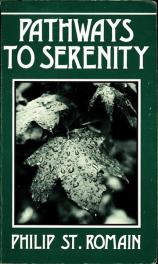Pathways to Serenity
by Philip St. Romain
Pathways to Serenity
by Philip St. Romain

PDF eBook: $3.99
"Clear and free of storms or unpleasant change; shining bright and steady; marked by utter calm."
This definition of serenity from Webster's Dictionary describes a most desirable state of mind, but how could one live in such a manner?
Sharing the fruit of his studies in Christian spirituality, psychology, Twelve Steps and Eastern mysticism, Philip St. Romain draws the best from each approach an combines them into a thoughtful and practical road map that leads to serenity.
Liguori Publications, 1987; Contemplative Ministries, Inc. 2012.
_________________
CONTENTS
Introduction
Experiencing serenity. Enemies of serenity. My search for a spirituality. Structure of this book. Acknowledgments.
PART ONE: Functions of Consciousness and Human Growth
1. Functions of Consciousness:
Definitions. Enumerations. Relationships. Reflection/Discussion Questions.
2. The Ego
Role of the Ego in consciousness. Primary human needs (physical and psychological) and the Ego. Reflection/Discussion Questions.
3. The Small Self
Definition. Fear and selfishness. Results seen in way needs are met. Small self as human sinfulness. Reflection/Discussion Questions.
4. The Christ Self
Definition. Love and human needs-fulfillment. Conversion. Reflection/Discussion Questions.
5. Stages of Spiritual Growth
Description of eight common Ego States. Ego States directed toward love or selfishness. Complexity of human nature. Reflection/Discussion Questions.
6. Spirituality and Personal Growth
Personal growth: movement through Ego States in love; Cosmic State: apex of growth. Roles of religion and psychology in growth and social considerations. Reflection/Discussion Questions.
PART TWO: Spiritual Living Skills
7. A Basic Approach to Spirituality
Spirituality: an approach to focusing consciousness in Christ. Simple and complex approaches. A basic approach emphasizing: prayer, honesty, awareness and benevolence, and inventory. Importance of spiritual living skills. Necessity of practice.
8. Right Actions
Relationship between morality and spirituality. Right actions: those which build up community. Wrong actions: those which tear down community. A list of generally recognized wrong actions. Corporal and spiritual works of mercy. Reflection/Discussion Questions.
9. Right Desires
Right desires: those which lead to right actions. Disciplining wrong desires through renunciation. Cultivating benevolent desires. Practicing these skills.
10. Right Use of Feelings
Role of feelings in consciousness. Three steps: accept them; express them appropriately; learn from them. Reflection/Discussion Questions.
11. Right Beliefs
Pivotal role of beliefs in consciousness. Programming your biocomputers. Right beliefs: those which lead to healthy feelings, desires, behaviors. A list of right beliefs about God, human nature, and the meaning of life. Reflection/Discussion Questions.
12. Right Values
Values: beliefs about the manner in which needs are met. Right values: those that help to meet needs in a loving way. Christian meaning of temperance, humility, prudence, justice, and fortitude. Reflection/Discussion Questions.
13. Right Awareness
Awareness: the focus of attention. Types of awareness. Development of awareness: reconciling with the past; facing the future; living in the present. Reflection/Discussion Questions.
14. Right Discernment
Definition: Choosing God's will among options. Based on certain assumptions. General guidelines. Reflection/Discussion Questions.
15. Spirituality and Grace
True definition of spirituality. Living skills for lay spirituality. Role of grace in transformation. Reflection/Discussion Questions.
PART THREE: Appendixes
Appendix One
Other Helpful Spiritual Practices
Appendix Two
New Pathways Spirituality: What It Is and How to Live It
Appendix Three
Pathways Spirituality. Its Psycho-spiritual Dynamics
Appendix Four
Pathways Support Group
Appendix Five
Notes on Christian Cosmic Consciousness
Suggested Reading